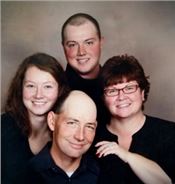|
SW Missouri Farmers And Ranchers Warming Up To Warm-Season Grasses

University of Missouri Extension specialist Tim Schnakenberg, left, works with Barry County farm manager
Lindell Mitchell to use warm-season Bermuda grass in his cow-calf operation
on the G&J Anderson Ranch at Seligman, Mo.
Photos credit: Linda Geist
SELIGMAN, MO.
Cattle grazing on lush green pastures tell the tale of why southwestern Missouri producers are warming up to warm-season grasses.
Barry County producer Lindell Mitchell sees several benefits from year-round grazing of warm-season Bermuda grass in his cow-calf operation.
Mitchell works with University of Missouri Extension specialists Tim Schnakenberg and Eldon Cole to improve forage and cattle quality.
Mitchell manages G&J Anderson Ranch, owned by Gary and Jane Anderson of Rogers, Ark. It straddles the Missouri-Arkansas border. Mitchell, his wife, Shelly, and grown children Ryan Mitchell and Britney Paul grow forage for the closed herd operation. They also manage two large on-ranch poultry operations.
Mitchell and Anderson use several varieties of Bermuda grass. Midland 99 and Cherokee are common varieties, but Greenfield Bermuda grass has been on the farm since the late 1970s and continues to perform well.
Bermuda grass is deep-rooted and grows to 24 inches in a variety of soils.
In most cases, Mitchell supplements winter grazing with triticale, a hybrid of wheat and rye. Rye is sometimes also used. He drills triticale into the Bermuda grass in September. Triticale allows grazing after frost and tolerates cold better than many other forages. This gives Mitchell a chance to take some grazing pressure off their stockpiled fescue for winter feeding. “It means less hay being fed,” he says.
The triticale’s early spring maturity gives cows “optimum groceries” as they lactate. Standing forage tests run on the ranch's triticale in February 2018 found 22 percent protein and 68 percent total digestible nutrients (TDN). This is much higher than standard fescue hay normally fed at that time of year, says Schnakenberg.
Bermuda grass withstands heat during June, July and August, when the quantity and quality of cool-season grasses wane.
Bermuda grass offers timing advantages too. It can be baled at more convenient times and offers nutrition for grazing cows and calves when they need it most. Bermuda grass matures faster than fescue. It can be baled every 30 days after June 1. Fescue harvest, on the other hand, usually begins around the first part of May when rain is more likely to delay cutting before seed heads form. Mitchell often runs the drill behind the baler on the last Bermuda grass cutting of the season around Labor Day weekend.
High nutrition also increases breeding success. Early calving means Mitchell's calves are ready for sale in August, when prices are higher. This means intensive early-winter calving (124 calves in 60 days this year). This puts calves on grass sooner and promotes early weight gain.
Mitchell also credits the local veterinary clinic with making the 60-day calving window possible. "Barry County Veterinary Clinic and Dr. Voyd Brown are a big part of our operation," says Mitchell. "They help with nutrition, ultrasounds and preg checks."
Even in the fall, the crude protein levels of Bermuda grass are impressive, says Schnakenberg. Tests on Nov. 30 on the ranch showed dormant and stockpiled Bermuda grass had 12 percent protein and 54 percent TDN. Bar Optima fescue hay from the previous season showed 15 percent protein and 62 percent TDN. Midland 99 Bermuda hay had 18.6 percent protein and 61 percent TDN. "These numbers are impressive for both the hay and the late fall standing growth of Bermuda,” he says.
Bermuda grass and triticale work well with the Sandhills calving system used on the ranch. When calving starts, dry cows are moved to pastures of fresh grass, and cow-calf pairs remain. This significantly reduced scours on the ranch during the past five years. “Clean grass makes the difference,” Schnakenberg says.
An abundant supply of grass makes rotational grazing more efficient. “We try not to waste grass,” Mitchell says. “We try not to waste hay.”
Fescue remains Missouri’s go-to forage, but Bermuda and other warm-season grasses can boost yields and reduce endophyte issues, says Schnakenberg. “We now believe that there is a place in the southern third of Missouri for Bermuda grass,” he says. “If Bermuda grass is not adapted for a farm or ranch, other warm-season options such as big bluestem, Indian grass, gama grass, Caucasian bluestem or crabgrass may be used.”
Warm-season grasses require different management than fescue. When used in a management-intensive grazing system, keep Bermuda post-grazing heights high and move cattle off pastures for rest periods. Graze when 6-8 inches high and no lower than 3-4 inches, Schnakenberg says. These grazing guidelines are much higher for native grasses like big bluestem.
Consider drawbacks as well, Schnakenberg says. Seeded Bermuda grass can be invasive. Cows may graze grass with seeds that transfer in manure or when hay bales are taken to other areas and unrolled. Army worms also like Bermuda grass. Overseeding with rye or triticale requires extra seeding expense and access to a drill.
Sprigged varieties cost more but don’t produce viable seeds. Schnakenberg says University of Arkansas research shows sprig varieties produce more growth.
Schnakenberg recommends that producers switch small numbers of acres to warm-season grasses to experiment and reduce risk.
Anderson initially switched about 30 percent of the land to a Bermuda, but now about 75 percent of the farm is in Bermuda and the remainder is mostly in novel endophyte fescue. This is a high percentage for most producers, but drilling triticale into the Bermuda works well for the ranch and allows for an abundance of high-quality feed year-round.
Amazingly, G & J Anderson Ranch uses a 1 to 1.5 cow per acre stocking rate. This is higher than most standards but works well with the ranch’s management practices.
“We’re getting all the pasture forage they want and still can cut hay,” Mitchell says.
Mitchell says he succeeds with the advice from Schnakenberg. “I value what Tim tells me. He’s my go-to. I call on extension quite regularly,” Mitchell says.
Anderson and Mitchell were early adopters of renovating away from Kentucky 31 fescue pastures, which cause losses in cattle, and converting to novel endophyte fescue varieties.
“Gary Anderson, Lindell Mitchell and his family are top-end, progressive producers,” says Schnakenberg. “They stay on the cutting edge in their industry.”
Visit the NRCS + MU Grasslands Project website at NRCS-GrasslandsProject.missouri.edu or contact an MU Extension agronomy specialist for more information. Download MU Extension’s free guide about Bermuda grass at extension.missouri.edu/p/g4620. ∆

Bermuda grass is deep-rooted and grows to 24 inches in a variety of soils.
Mitchell drills triticale into the Bermuda grass. This allows grazing after frost.

Lindell and Shelly Mitchell and their two grown children, Ryan Mitchell and Britney Paul, work
together on the ranch. They also manage two large on-ranch poultry operations.
|
|